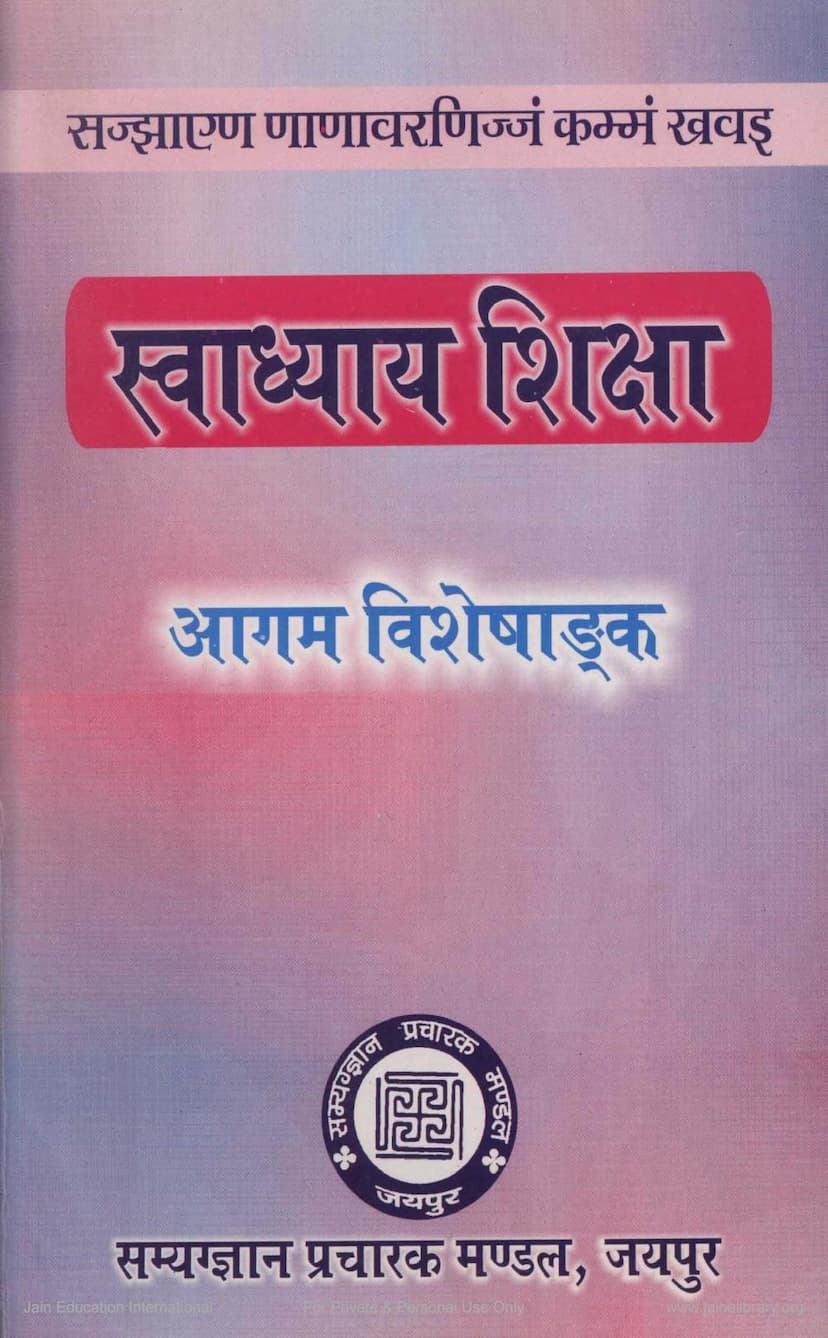Swadhyaya Shiksha
Added to library: September 2, 2025

Summary
Here's a comprehensive summary of the Jain text "Swadhyaya Shiksha (Agam-Visheshank)" by Dharmchand Jain, based on the provided pages:
Overview:
"Swadhyaya Shiksha" is a Jain text published by Samyagyan Pracharak Mandal, Jaipur. This particular edition is an "Agam-Visheshank," meaning it is a special issue dedicated to Jain Agams (scriptures). The book aims to increase scholarly knowledge of Jain Agams and is a collection of articles by various scholars on diverse topics related to these scriptures. It was published in February 2003.
Key Themes and Content:
The book covers a wide range of subjects derived from Jain Agams, including:
- The Principal Tenet of Jain Agams: Vitaraagta (Non-attachment/Dispassion): This article likely explores the central concept of achieving a state of non-attachment and dispassion as the ultimate spiritual goal in Jainism, as outlined in the Agams.
- Psychological Analysis of the Acharanga Sutra: This section delves into the Acharanga Sutra, one of the most ancient Jain Agams, from a psychological perspective. It likely examines how the Agam's teachings on conduct and ethics relate to human psychology, mind, and behavior.
- Science in Jain Agams: This article explores the presence of scientific knowledge and principles within the Jain Agams. It suggests that the scriptures contain elements related to physics, chemistry, biology, medicine, mathematics, astronomy, and psychology, both in the material and the abstract realms.
- The Nature of Education in Jain Agams: This section discusses the educational system and principles as described in the Jain scriptures. It emphasizes the importance of character building, spiritual knowledge alongside practical knowledge, and the role of the guru-disciple tradition.
- Environmental Protection in Jain Agams: This article highlights the Jain Agams' emphasis on environmental conservation. It likely connects principles like non-violence (ahimsa), non-possession (aparigraha), and the sanctity of all living beings (including plants and microorganisms) to ecological balance and the avoidance of pollution.
- Aesthetic-Literary Review of the Ardhamagadhi Agam Literature: This section provides a literary analysis of the Agamic literature written in Ardhamagadhi Prakrit. It likely examines the poetic qualities, use of literary devices, and aesthetic value of these scriptures.
- Acharanga Sutra: A Psychological Analysis: This appears to be a continuation or expansion of the earlier mention of the Acharanga Sutra, providing a deeper psychological interpretation of its teachings on conduct.
- Essential Sutras (Aavashyak Sutra): This article likely offers an introduction to the Aavashyak Sutra, which outlines the six essential daily duties for Jain monks and nuns (Sthaviras) and lay followers (Shravakas).
- Musical Art in Agam Literature: This section explores the presence and significance of music, dance, and musical instruments as depicted in the Jain Agams, reflecting their role in religious and cultural life.
- Non-violence (Ahimsa) in Jain Agams: This article likely focuses on the paramount importance of ahimsa in Jainism, as a fundamental principle enshrined in the Agams, and its implications for personal life and society.
- The Relationship between Mati-Gyan and Shrut-Gyan in Jain Agams: This section delves into the epistemological aspects of Jainism, explaining the connection and interdependence between sensory perception and knowledge gained through scripture and testimony (Mati-gyan and Shrut-gyan).
- The Importance of Agams: This article likely emphasizes the foundational role of the Agams in Jain philosophy, practice, and spiritual development.
- The Nature of the Learner (Shiksharthi) in Jain Agams: This section describes the ideal characteristics and qualities of a student or spiritual seeker as defined by the Jain Agams, focusing on attributes like discipline, humility, and the pursuit of knowledge.
- Dashashrutaskandha: An Introduction: This article provides an overview of the Dashashrutaskandha, a significant text within the "Chhed Sutras" (texts dealing with conduct, discipline, and penance), likely outlining its structure and key teachings on monastic life and ethical conduct.
- The Universally Accepted Form of Jain Agams: This section likely discusses the widely accepted classifications and categories of Jain Agams across different traditions.
- Analysis of Certain Words in Agam Literature: This article likely provides linguistic and philosophical explanations of specific technical terms used in Jain Agams, highlighting their precise meaning and significance.
Key Contributors:
The "Agam-Visheshank" features contributions from several distinguished scholars and figures in Jainism, including:
- Dr. Dharmachand Jain (Editor)
- Shri Sampatraj Dosi
- Dr. Sagar Mal Jain
- Dr. Nandlal Jain
- Shri Dulichand Jain 'Sahityaratna'
- Shri Kanhaiyalal Lodha
- Dr. Harishankar Pandey
- Shri Parasmal Chandalia
- Samani Sambodh Pragya
- Shri Ratanlal Bafna
- Dr. Rajkumari Jain
- Dr. Rajiv Prachandiya
- Sushri Shweta Jain
- Shri Jashkaran Daga
- Shri Ramesh Muni Shastri
Publisher and Support:
The publication was made possible through the generosity of A.B. Shri Jain Ratna Hiteshi Shravak Sangh, Indore. Samyagyan Pracharak Mandal, Jaipur, acted as the publisher.
Overall Purpose:
The "Agam-Visheshank" aims to illuminate the rich and profound knowledge contained within the Jain Agams, encouraging readers to engage with these sacred texts for personal growth, spiritual understanding, and the betterment of society. It highlights the Agams as a source of wisdom on various aspects of life, from spiritual principles to scientific observations and ethical conduct. The publication also acknowledges the valuable contributions of scholars who have dedicated themselves to the study and dissemination of Jain Agamic literature.